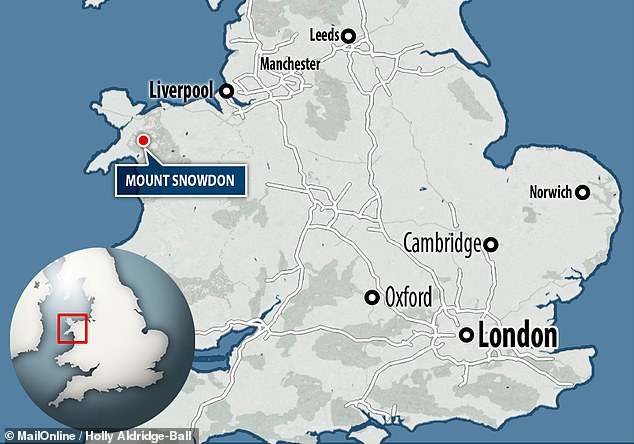A survey to determine whether Mount Snowdon could be turned into a plastic-free zone has revealed large amounts of microplastics on the Welsh summit.
The survey — conducted by the French geophysical services company CGG — found that plastics accumulated where people tend to congregate on the mountain.
Furthermore, the researchers reported that microplastics particles represented a concerning 5 per cent of the total sample that they collected at Snowdon’s summit.
The findings come after reports that ‘staycations’ have caused tourist numbers on Snowdown to soar — with July once seeing a 45 minute queue for the summit.

A survey to determine whether Mount Snowdon (pictured) could be turned into a plastic-free zone has revealed large amounts of microplastics on the Welsh summit
MOUNT SNOWDON
Snowdon — located in the Snowdonia National Park — is Wales’ highest peak.
The summit stands 3,560 feet (1,085 metres) above sea level.
The mountain is the busiest in the United Kingdom and third most popular attraction in Wales — and is presently thought to bring in some 700,000 visitors annually.
Snowdon was formed as a result of volcanic activity during the Ordovician period, some 458–457 million years ago, which left ash flows that reached 1,600 feet (500 metres) thick in areas.
The landscape — including Snowdon’s pyramidal peak — have since been extensively shaped by glaciation.
Advertisement
‘These results are a stark reminder of how persistent plastic is when it gets into the environment,’ said Snowdonia Society director John Harold, who is also chair of Partneriaeth Yr Wyddfa (the ‘Snowdon Partnership’).
‘A huge amount of litter is cleared by staff and volunteers —but by no means all gets picked up,’ he continued.
‘This work shows what happens when plastic is let loose in the soils and freshwater of our precious protected areas; it breaks into countless particles and we lose control of it.
‘Once again this really highlights the need for us all to be extra careful when visiting protected areas,’ he concluded.
From their findings, the CCG scientists have determined a ‘microplastic pollution index’ for Snowdown, which is used to help local authorities, government agencies and other organisations identify areas of plastic leakage.
The index indicated that the lion’s share of microplastic particles found on Snowdown were either considerably abraded pieces of large plastic bodies, or plastics fibres shed from items of clothing.
With the study complete, the Snowdonia National Park Authority will now look to using the data to make the public more aware of plastic pollution — alongside considering the practicalities of introducing plastic-free areas in the park.
‘With the growing need for clear and transparent environmental information, CGG’s innovative microplastic analysis technique provides detailed microplastic pollution information,’ said CGG executive vice president for geoscience, Peter Whiting.
‘Through continued investment in technology, CGG is developing advanced workflows to generate data that is key to addressing global environmental challenges such as plastic pollution.
‘This technique complements our other plastic pollution monitoring initiatives, such as our ongoing European Space Agency project to monitor plastic pollution from space,’ he concluded.

The survey — conducted by the French geophysical services company CGG — found that plastics accumulated where people tend to congregate on Mount Snowdon
WHAT FURTHER RESEARCH IS NEEDED TO ASSESS THE SPREAD AND IMPACT OF MICROPLASTICS?
The World Health Organisation’s 2019 report ‘Microplastics in Drinking Water’ outlined numerous areas for future research that could shed light on how far spread the problem of microplastic pollution is, how it may impact human health and what can be done to stop these particles from entering our water supplies.
How widespread are microplastics?
The following research would clarify the occurrence of microplastics in drinking-water and freshwater sources:
More data are needed on the occurrence of microplastics in drinking-water to assess human exposure from drinking-water adequately. Studies on occurrence of microplastics must use quality-assured methods to determine numbers, shapes, sizes, and composition of the particles found. They should identify whether the microplastics are coming from the freshwater environment or from the abstraction, treatment, distribution or bottling of drinking-water. Initially, this research should focus on drinking-water thought to be most at risk of particulate contamination. Drinking-water studies would be usefully supplemented by better data on fresh water that enable the freshwater inputs to be quantified and the major sources identified. This may require the development of reliable methods to track origins and identify sources. A set of standard methods is needed for sampling and analysing microplastics in drinking-water and fresh water. There is a significant knowledge gap in the understanding of nanoplastics in the aquatic environment. A first step to address this gap is to develop standard methods for sampling and analysing nanoplastics.
What are the health implications of microplastics?
Although water treatment can be effective in removing particles, there is limited data specific to microplastics. To support human health risk assessment and management options, the following data gaps related to water treatment need to be addressed:
More research is needed to understand the fate of microplastics across different wastewater and drinking-water treatment processes (such as clarification processes and oxidation) under different operational circumstances, including optimal and sub-optimal operation and the influence of particle size, shape and chemical composition on removal efficacy. There is a need to better understand particle composition pre- and post-water treatment, including in distribution systems. The role of microplastic breakdown and abrasion in water treatment systems, as well as the microplastic contribution from the processes themselves should be considered. More knowledge is needed to understand the presence and removal of nanoplastic particles in water and wastewater treatment processes once standard methods for nanoplastics are available. There is a need to better understand the relationships between turbidity (and particle counts) and microplastic concentrations throughout the treatment processes. Research is needed to understand the significance of the potential return of microplastics to the environment from sludge and other treatment waste streams.
To better understand microplastic-associated biofilms and their significance, the following research could be carried out:
Further studies could be conducted on the factors that influence the composition and potential specificity of microplastic-associated biofilms. Studies could also consider the factors influencing biofilm formation on plastic surfaces, including microplastics, and how these factors vary for different plastic materials, and what organisms more commonly bind to plastic surfaces in freshwater systems. Research could be carried out to better understand the capacity of microplastics to transport pathogenic bacteria longer distances downstream, the rate of degradation in freshwater systems and the relative abundance and transport capacity of microplastics compared with other particles.Research could consider the risk of horizontal transfer of antimicrobial resistance genes in plastisphere microorganisms compared to other biofilms, such as those found in WWTPs.
Can water treatment stop microplastics entering our water supplies?
Although water treatment can be effective in removing particles, there is limited data specific to microplastics. To support human health risk assessment and management options, the following data gaps related to water treatment need to be addressed:
More research is needed to understand the fate of microplastics across different wastewater and drinking-water treatment processes (such as clarification processes and oxidation) under different operational circumstances, including optimal and sub-optimal operation and the influence of particle size, shape and chemical composition on removal efficacy. There is a need to better understand particle composition pre- and post-water treatment, including in distribution systems. The role of microplastic breakdown and abrasion in water treatment systems, as well as the microplastic contribution from the processes themselves should be considered.More knowledge is needed to understand the presence and removal of nanoplastic particles in water and wastewater treatment processes once standard methods for nanoplastics are available. There is a need to better understand the relationships between turbidity (and particle counts) and microplastic concentrations throughout the treatment processes. Research is needed to understand the significance of the potential return of microplastics to the environment from sludge and other treatment waste streams.Advertisement
Source link : https://www.dailymail.co.uk/sciencetech/article-9922771/Pollution-Mt-Snowdon-plastic-free-zone-amid-concerns-microplastics-summit.html












